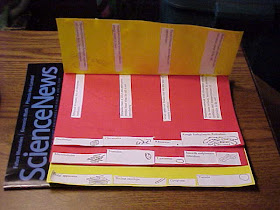I found this review that I had put together for Chapter 3 in Kendall/Hunt, Prime Science, Level 1. This might be an interesting way to talk about safety, in addition to going over laboratory safety rules. It's a different way of integrating basic chemistry knowledge with practical everyday application of chemistry to people's lives. All students have seen tanker trucks on the highways.
Mastery Review-Transporting Chemicals
1. What are chemicals?
Made up of matter
Atoms and Elements
Compounds
2. What is the importance of the chemical industry?
Important to manufacturing because it converts raw materials into chemicals that are used to make the products we buy.
Chemicals are made in large amounts (bulk chemicals).
Converts raw materials into products that are used directly, such as fuel.
3. How do you handle chemicals safely?
You need to be able to identify the chemical being transported and need access to information about the chemical.
Proper Labeling
Chemicals need to be properly packaged.
Chemicals need to be transported safely.
Teams of people need to be properly trained to dispose of hazardous materials.
4. What kind of information is on the chemical warning signs?
Hazard Classification (what kind of danger may arise)
Substance name and number code.
5. How to you identify chemical hazards?
Test for:
Flammability
Corrosion of metals
Is the chemical an acid or base?
What substances does the chemical react with?
6. How do you handle chemicals safely?
Know where to find out information about the chemicals.
Use the proper procedures for hazardous chemicals.
Know how to administer first aid.
7. What is the international code for chemistry?
A shorthand system for representing chemicals.
Elements are represented by international symbols.
8. How do we describe chemical reactions?
Word equations
Symbol equations
Balanced equations
9. Who are some important chemists?
John Dalton – said all matter is made of atoms
John Newlands – in 1863, he made the first periodic table by arranging the elements in the order of increasing masses of their atoms.
Dimitri Mendeleev – arranged the elements in the order of increasing masses and also according to similar properties (he put them in columns).
10. How is the modern periodic table used?
One can find the atomic number. (number of protons)
The vertical columns have chemicals with similar properties. (Groups)
One can find out the symbol and name of each element.
One can read a key to find out if an element is a metal, nonmetal, or gas
One can find out the atomic weight, which along with the atomic number, can indicate number of electrons, protons, and neutrons in an atom.



















